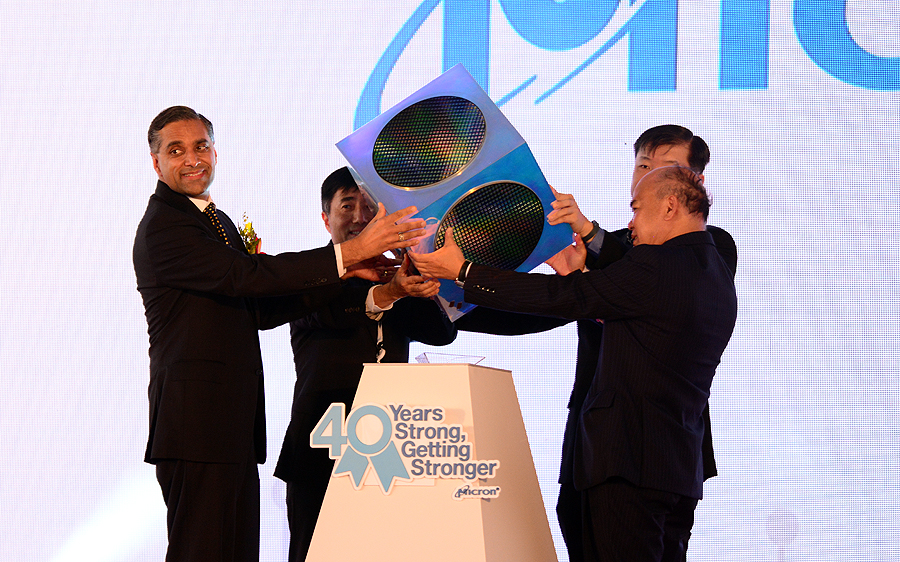Micron's Momentum Continues
Micron Technology is starting its new fiscal year on a high note, reporting quarterly revenue of $6.8 billion, while continuing to reduce operational costs and retire debt.
The strong numbers for the quarter build on momentum established over the past calendar year. Revenue for this latest quarter is 71 percent higher compared with the same period last year, and 11 percent higher compared to the previous quarter, the fourth quarter of Micron's fiscal 2017. In a news release, Micron said the results were due to an increased demand for our mobile, server and SSD products.
The company's overall consolidated gross margin of 55.1 percent for the fiscal first quarter of 2018 was higher compared to 50.7 percent for the fourth quarter of 2017 and reflects margin expansion for both DRAM and trade NAND products supported by ongoing strength in the pricing environment and a favorable product mix.
Micron's investments in capital expenditures, net of amounts funded by partners, were $1.92 billion for the first quarter of 2018. During the quarter, the company raised $1.36 billion from an equity offering and repurchased or converted $2.36 billion principal amount of its debt, thereby lowering total face value debt to $9.34 billion exiting the quarter. Micron ended the first quarter with cash, marketable investments and restricted cash of $6.61 billion.
In a webcast for press and analysts, Micron President and CEO Sanjay Mehrotra said the quarter also focused on speed and execution, and saw the company become more cost competitive and improve its supply chain management with appointment of Manish Bhatia to lead its global operations. He said the company has achieved yield maturity on its 1X nm DRAM and 64-layer 3D NAND. Fiscal 2018 will focus on transitions for DRAM and NAND without changes to wafer output, while 2019 will be about moving to more advanced nodes.
Micron continues to benefit from favorable pricing environment for both DRAM and NAND, hitting record revenues for its SSDs and increasing its share of the market. The quarter also saw Micron launch its high density 32 GB NV-DIMM, which Mehrotra said is garnering solid interest from its cloud and enterprise customers, which are also continuing to drive demand for both SSDs and DRAM.
The mobile segment also delivered record revenue in the quarter, said Mehrotra, as the need to access, store and analyze data beyond the cloud continues to grow. The company is also expanding its low power products to meet the demand for home automation and edge computing devices that must store and process more data. And as more edge devices integrate artificial intelligence and machine learning, he said, the company sees more opportunity to incorporate memory.
Micron is bullish on the automotive market to drive demand for memory. “Automotive customers are moving more rapidly to new memory technologies than they have in the past," said Mehrotra. Autonomous vehicles will need 40 GB of DRAM content, he said, and given all the data these intelligent vehicles need to drive themselves and keep drivers safe, there will be a lot of NAND flash too. “These cars will be very powerful computers in the future," he said.
Jim Handy, principal analyst with Objective Analysis, said the autonomous vehicle boon for memory is on the horizon, but we're not going to get there as fast as Micron is touting. “The big question is how quickly they will take over the roadways," Handy said. He said it will be a “bonanza" for companies making the necessary technologies. However, regulatory hurdles remain, and car buyers will likely be tentative to make their first purchase.
Otherwise, Handy said there weren't any surprises in the Micron's first quarter of the year given the industry is still facing a NAND flash shortage, with prices either going up or down slightly. “Pricing has been very solid for NAND flash and DRAM." He said the company is doing a good job of taking advantage of a favorable pricing environment to improve the cash position. “That will put them in strong position during the next downturn."
Micron is in better shape than most companies in the industry, Handy said, and the company is improving its production of 3D NAND and 1X nm DRAM. “They're taking advantage of the upturn." During a shortage, Handy said, it's good time to walk away from the low margin business and grow the higher margin ones. "Micron is doing exactly that."
Mehrotra said that Micron would talk about 3D Xpoint at an upcoming analyst event, but for now only said it is putting a product development team in place and working with players in the ecosystem.
Handy said Intel is the one company most interested in 3D Xpoint by putting it into SSDs for servers that have its processers. “There's no reason to think yet that it's capable of generating profits for any company who sells it, he said. “Micron is probably going to wait for Intel take all of the losses."
在线留言询价

Micron to buy-out Intel's IM Flash

Micron Sees Weak Market Ahead

Micron collaborates with premium German automaker to advance automotive memory technologies
- 一周热料
- 紧缺物料秒杀
| 型号 | 品牌 | 询价 |
|---|---|---|
| BD71847AMWV-E2 | ROHM Semiconductor | |
| RB751G-40T2R | ROHM Semiconductor | |
| MC33074DR2G | onsemi | |
| CDZVT2R20B | ROHM Semiconductor | |
| TL431ACLPR | Texas Instruments |
| 型号 | 品牌 | 抢购 |
|---|---|---|
| STM32F429IGT6 | STMicroelectronics | |
| ESR03EZPJ151 | ROHM Semiconductor | |
| IPZ40N04S5L4R8ATMA1 | Infineon Technologies | |
| BU33JA2MNVX-CTL | ROHM Semiconductor | |
| BP3621 | ROHM Semiconductor | |
| TPS63050YFFR | Texas Instruments |
- 周排行榜
- 月排行榜
AMEYA360公众号二维码
识别二维码,即可关注

























